Our top picks
The name Takarazuka may remind people more of the Takarazuka Revue all-female theater company than of onsen (hot springs), but the two have historically gone hand-in-hand. This makes the city a place of musical dreams and healing waters. So take advantage of Takarazuka’s unique offerings by following musical entertainment with a slow and relaxing hot-spring bath.
An onsen is also the ultimate end to a day of hiking along the Rokkō Traverse Trail.
Takarazuka Onsen can be enjoyed at any of three locations near Takarazuka Station: Hotel Wakamizu, Nature Spa Takarazuka, and Takarazuka Washington Hotel. Or, take the train three stops from JR Takarazuka Station to Takedao Station, where you can enjoy Takedao Onsen at either Kōyōkan Bettei Azalée or Takedao Motoyu.
There are two types of water in Takarazuka Onsen: the iron-rich, cloudy brown “gold” spring water and the clear “silver” spring water. The “gold” is cold mineral spring water that is mildly radioactive and rich in sodium and chloride. It is said to be an effective treatment for gout, rheumatoid arthritis, and other ailments. The “silver” is also cold mineral spring water that contains sodium and chloride. It is reputed to help cure peripheral circulatory disorders, dry skin, and other ailments. Whatever kind of water you soak in, you’ll feel warm and toasty, and you won’t get the chills after leaving the bathtub. So by all means, enjoy both types of Takarazuka Onsen water.
Takarazuka Onsen goes back as far as Japan’s Kamakura Period (1185–1333), although they didn’t take their present form until the Meiji Period (1868–1912). The formation in 1914 of a young women’s musical troupe, the predecessor to the Takarazuka Revue, helped turn the city into a bustling hot spring resort. 1970 was the year of Osaka Expo ‘70, when 1.33 million visitors stayed at hotels in Takarazuka. In 1974, the Revue held the first performance of its signature musical, The Rose of Versailles, bringing even more musical fans to enjoy a hot-spring bath after a show.
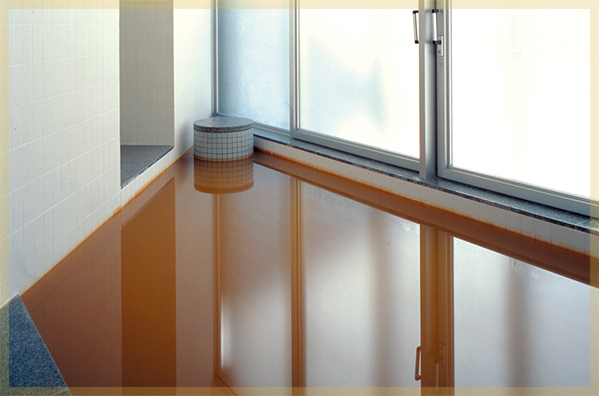
One of the mysteries of Takarazuka is how it can draw natural spring water despite the lack of volcanic activity. Takarazuka Onsen is situated along an active fault line, called the Arima-Takatsuki Tectonic Line. One theory says that this fault line sits on top of the Philippine Sea Plate running from the Pacific Ocean to deep under Japan’s Kinki region and whenever the plate sinks it causes pressure that releases mineral-filled water that is the source of Takarazuka Onsen. By the way, this water travels an amazing 60 km upwards to reach Takarazuka!
Celebrating its 65th anniversary in 2016, Hotel Wakamizu is one of Takarazuka’s leading hotels and a proud bearer of the city’s onsen tradition. At the entrance of the bathroom on the eighth floor there is a “Takarazuka Onsen” sign from 1897 that had been washed down the river all the way to the ocean in Hamadera in Sakai City when the Mukogawa River flooded. Even if you’re not staying at the hotel, you can enjoy a specially priced meal and hot-spring package. Besides a large bath with a view and an open-air bath, there’s a cypress-wood bathtub you can reserve in order to enjoy a sumptuous bath in quiet privacy.
Women can enjoy a rose-petal-filled open-air bath every Monday and Saturday from 16:00 to 24:00. Cleopatra reputedly took rose-petal baths for the stress- and fatigue-releasing powers and the sleep-inducing effects of the fragrance. The gentle flowery aroma continues to sooth your body and mind long after you get out of the bath.

Enjoy Takarazuka’s renowned hot springs on a day trip. With a public bath, spa, ganban-yoku (a bed of heated rocks), fitness center, and massage area, Nature Spa Takarazuka is a great place for a mental and physical recharge.
Nature Spa Takarazuka’s spring water is either cloudy brown “gold” spring water or clear “silver” spring water. The “gold” spring water is rich in iron. By the way, Nature Spa Takarazuka is the only local onsen facility where you can soak in both types. Don’t forget to check out the spacious open-air jacuzzi on the fourth floor.
Note that you need to wear a bathing suit in the women-only spa pool and the mixed-sex open-air jacuzzi. Bathing suits are available for rent.
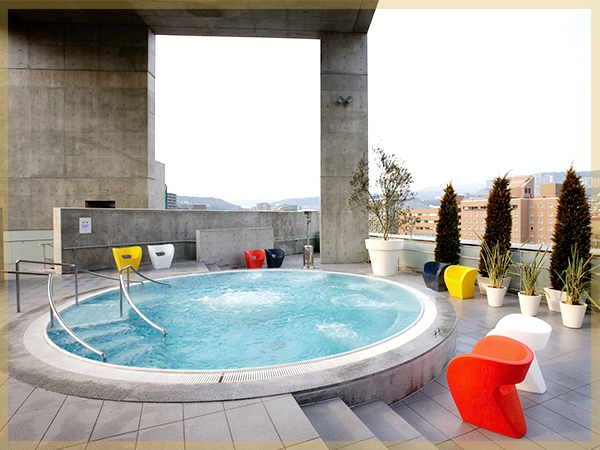
Situated on the banks of the Mukogawa River, the Takarazuka Washington Hotel offers patrons a luxurious hot-spring experience that includes a sauna and onsen baths with a view. The hotel’s location near Takarazuka Station and on the north side of Mukogawa lets you gaze out over the river for a view of the mountains stretching all the way to Mount Rokkō. You’ll totally forget you’re in the city.
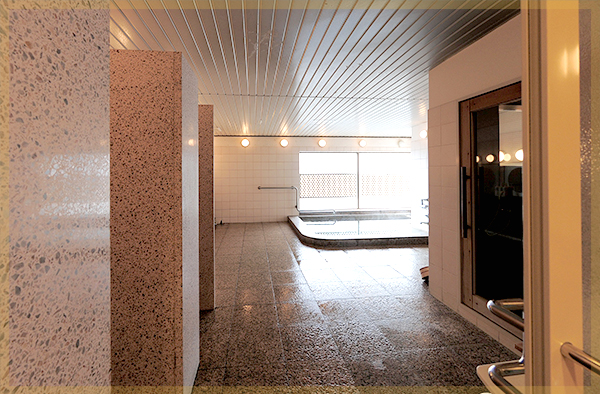
If you’re looking for a souvenir, Takarazuka bath salts allow you to literally take Takarazuka Onsen home to enjoy. There are two types: Takarazuka no Yu, which recreates the authentic “gold” spring water experience, and Otome no Yu, which simulates “silver” spring water with the color and fragrance of violets. You can purchase these at the Takarazuka International Tourism Association, Hotel Wakamizu, Takarazuka Washington Hotel, Nature Spa Takarazuka, and other locations. So take Takarazuka Onsen home to your own bathroom.
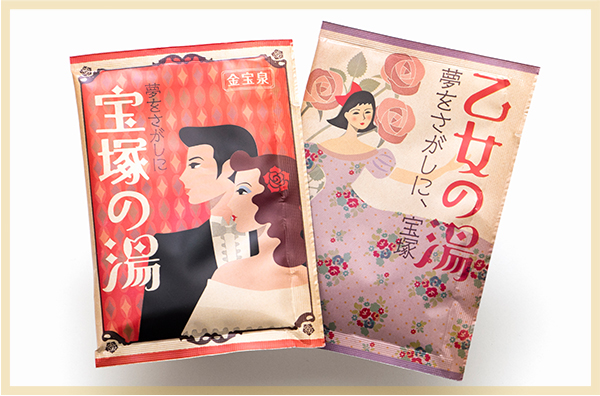
A renowned local delicacy are Takarazuka tansan senbei: crackers made from dry ingredients like flour and sugar and mixed with carbonated spring water. Besides brands like the 120-year-old Koganeya, many stores along the path to Kiyoshikōjin temple and in other areas of the city make their own homemade versions. So why not buy a few of each and taste the difference for yourself. Although tasty just as they are, tansan senbei are great topped with whipped cream or butter cream, or crumbled into melted chocolate and then hardened.
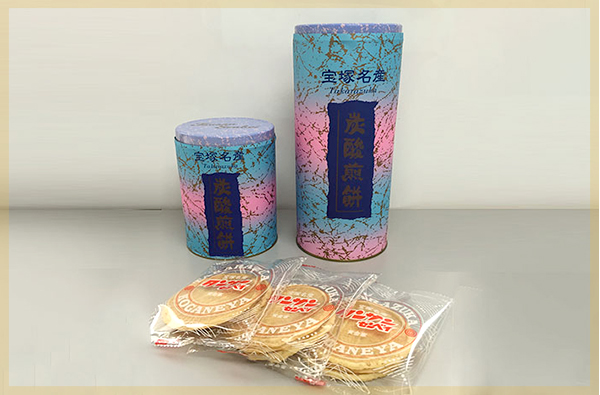
The water of Takedao Onsen contains slight amounts of radon and is rich in sodium, calcium, and chloride. It is said to be effective against fatigue, gastrointestinal disorders, skin disorders, neuralgia, sore muscles, bruises, sensitivity to cold, gynecological diseases, high blood pressure, and gout.
Takedao Onsen was discovered in 1641. Its popularity grew with the building of a railway through the area in the late 19th century, when it came to be nicknamed “Kansai’s inner sanctum.” Just eight minutes by train from JR Takarazuka Station, Takedao Onsen is like a secret hideaway.
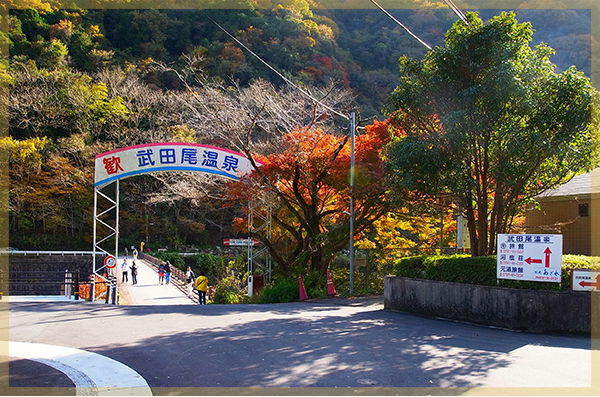
This out-of-the-way resort combines hot springs and gourmet meals. All guest rooms are cottages equipped with a semi-open-air gensen kakenagashi bath (a bath using only pure, unfiltered onsen water that springs directly from the earth). You’ll notice the atmosphere here is different than in Takarazuka as you gaze down on the spectacular Mukogawa Gorge while surrounded by the rustic charm of the facilities. Bathing in the room’s semi-open-air bath will make you feel like you’re in a remote village, with only the sounds of the rushing river, the rustling leaves, and the occasional train in the distance. You don’t have to stay at the hotel to enjoy its hot springs. There’s even a free-of-charge hot-spring foot bath to rest your tired feet after hiking.
The menu at the hotel’s Shin restaurant was created by the renowned chef Toshirō Kandagawa. Enjoy kaiseki—a traditional Japanese-style banquet meal—or local specialties like botan nabe (wild boar hot pot), sukiyaki or shabu-shabu made with Sanda beef, or a range of original dishes. Check out the website for specials combining a hot spring bath with lunch or kaiseki meal.
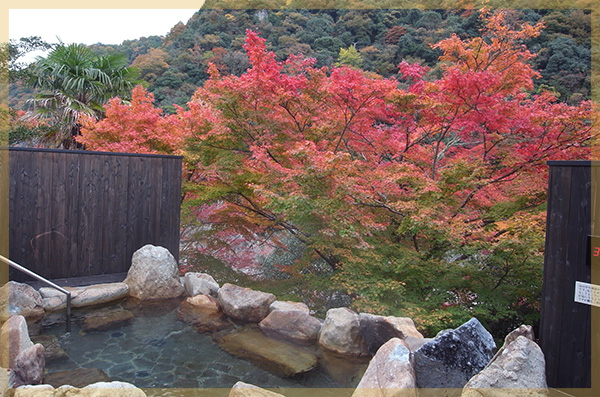
Motoyu is an onsen nestled in the mountains near Takedao. If you’re on a day trip, you can take an-hour long hot spring bath, or treat yourself to a three-hour session that includes a bath plus a meal of sukiyaki or shabu-shabu in a private room. You can even book an entire hot spring bath for you and your group. Be sure to check the website before you come, since it’s closed on certain days.